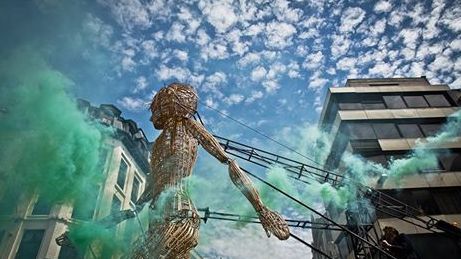The one thing we know is that urbanization is on the rise around the globe. So more and more people are moving into cities because they want the arts and culture the city has to offer, but land becomes more valuable. So it’s about how we create pathways of ownership for artists and arts organizations so they’re not forced to deal with the broader markets that tend to be more aggressive than artists can afford.
And how do you do that in San Francisco?
One of our great models is the Community Arts Stabilization Trust, (CAST) which has recently benefited from a seed gift from the Kenneth Rainin Foundation of $5 million.
They’re also the organization working in partnership with the Northern California Community Loan Fund to stabilize those non-profits funded through $2 million through our Board of Supervisors and Mayor’s office.
Of course that doesn’t help the many individual artists who have lost their studios to a tech company. Any ideas from the forum that might help them?
One thing we’ve looked at locally, something other cities have had success with, is the zoning of space that is most conducive to artists. In the US and San Francisco that is referred to as PDR, or Production, Distribution and Repair space. So if you’ve wondered why artists often find studios in spaces that are near auto repair or warehouses, it’s because that’s usually zoned PDR. So one of the things we’re looking at here at the Arts Commission is how do we work with the Planning Department to ensure a good proportion of PDR, because that creates a market that artists can access. So the cost per square foot of that space tends to be lower. Other cities like London and Shanghai have found great success with equivalent zoning that protects space for artist use.
The Forum published a financial report this year comparing 24 of the cities in attendance. The reports says that San Francisco invests more than $100 per capita in arts and culture. A lot of that money comes from the hotel and restaurant tax. Meanwhile, Los Angeles invests just $11 per capita. What do you make of that disparity?
Well the electorate and elected officials in San Francisco have a real sense of the value of arts and culture, so they’ve made a decision that they want a public investment. And San Francisco leads the country in that regard.
And yet a lot of artists from San Francisco have sought refuge in LA because they can do their work and still find affordable rents.
That’s part of the reason we’ve seen an increase in our public investment in the arts in the past couple of years. So we have a non-profit displacement mitigation fund, which is helping many arts and culture organizations stay in the city, and most recently has helped a number of organizations renegotiate their leases.
I understand that London is facing a music venue crisis. The city has lost about a third of its clubs and music halls over the past five years. We’ve had similar threats in San Francisco, where people move into a neighborhood and then complain about the noise. What did you learn at the culture forum that might be applicable here?
Well London is looking at a number of solutions. And now they’ve put deed restrictions on units of new residential housing near historic music venues. It actually prevents the owner of that new residence from ever submitting a sound complaint against that music venue. I know we’ve had some legislation in San Francisco that is studying the sound impacts on residential development. But I think London is really leading the way.
San Francisco was the only Bay Area city to attend this global forum. Did you come away with any suggestions for cities like Oakland or San Jose which may be dealing with these same problems?
We really did represent the Bay Area. And I think there’s a call for greater regional planning. I’ve been working closely with my counterpart in San Jose, Kerry Adams Hapner, the President of the US Urban Arts Federation, to insure how we can regionally make sure the the Bay Area remains an affordable place for artists.
Underlying the London forum was this idea of “creative placemaking,” where the arts are a key part of city policy. So what did you bring back from the forum to help maintain that ideal?
As important as creative placemaking can be to improving the quality of life of a city, I think we also have to be concerned with creative placekeeping. It’s a term coined by Roberto Bedoya of Tuscon-Pima Arts Council, and it’s really about how do we insure as municipal governments that artists and arts organizations continue to thrive where they are. These are the people who have made our neighborhoods unique — that people want to come and be a part of. We want to welcome new people to the party, but we also want to make sure that they’re respectful of the people who made this city such a great place to live in and play in in the first place.



